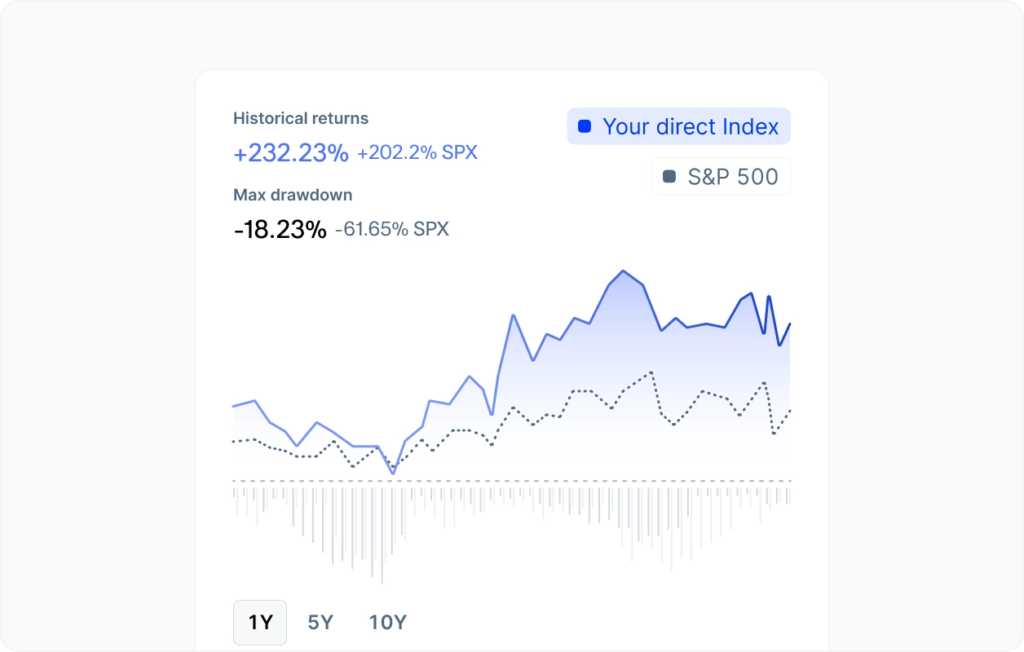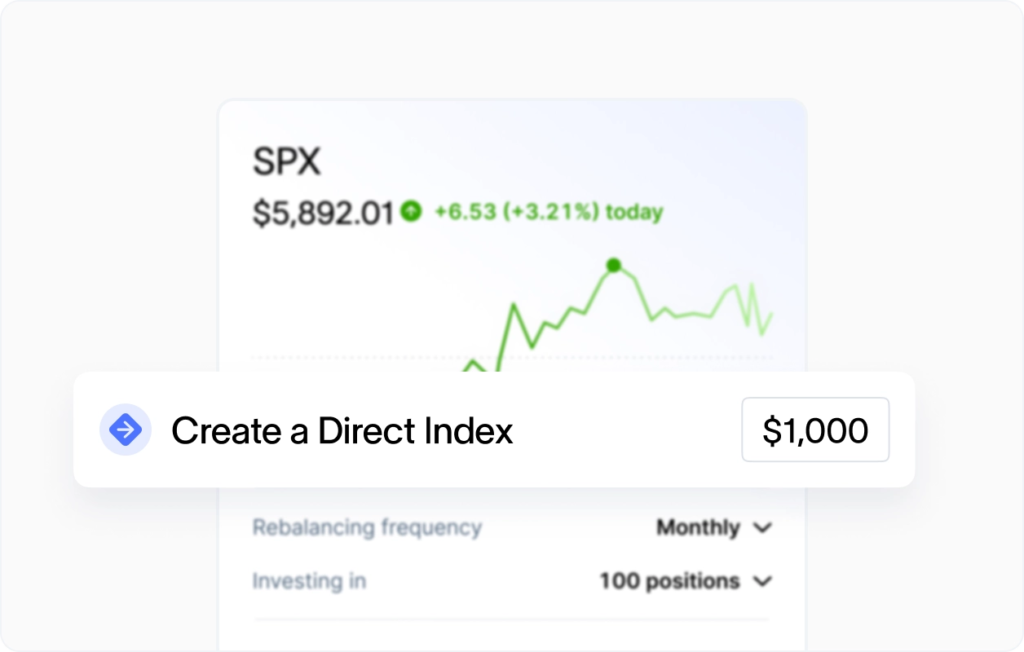Direct indexing.
Fully customized. Tax-optimized.
*For illustrative purposes only. Not a recommendation of any security, index, or strategy.
Personalize your index
Automated tax-loss harvesting
Directly own each asset
Choose an index.
Make it your own.
01
Set your foundation
There are over 100 indices to choose from, including the S&P 500®, Solactive AI Technology Index, and S&P Gold®.
02
Weight your positions
Your holdings can be weighted by market cap, to match the index, or split evenly across all positions.
03
Set your rebalancing schedule
Our technology automatically scans for tax-loss harvesting opportunities with each portfolio rebalance and each cash deposit/withdrawal.
04
Personalize your holdings
You can remove any individual stock that don’t align with your values or strategy.
Tax-loss harvesting
Lower your tax bill.
Increase your after-tax returns.
With direct indexing, you can take advantage of tax-loss harvesting—a strategy designed to improve your after-tax returns. Tax-loss harvesting works by selling investments that have declined in value to help offset the taxes you might owe on your gains.
01
Scan
Our technology will automatically scan for tax-loss harvesting opportunities every time your index rebalances or you deposit or withdraw funds.
02
Harvest
We’ll sell declining investments, capture the losses, and replace them with similar-performing assets—so your portfolio stays aligned with your index.
03
Optimize
Harvested losses can be used to offset capital gains, potentially lowering your tax bill and increasing your portfolio’s after-tax return potential.
Images above are hypothetical and for informational and illustrative purposes only. The ability of tax loss harvesting to reduce tax liability is not guaranteed and will depend on your entire tax and investment profile.
Hear from Public COO, Stephen Sikes
“Direct indexing is a strategy wealthy investors and institutions have relied on for years. And now, on Public, it’s available to everyone.”
* For informational purposes only. Not tax or investment advice.
Test your strategy before you invest
We'll show you how your customized index compares to the S&P 500®, with a unique asset score based on its returns, stability, and diversification.

* For illustrative purposes only. Not actual performance results.
Get started with as little as $1,000
Direct indexing on other platforms typically requires a six-figure minimum. On Public, you can get started with an initial investment of just $1,000.*
* A $1,000 initial investment may only enable you to track some, but not all, of a particular benchmark index's stocks.

*For illustrative purposes only. Not a recommendation of any index or strategy.
Side by side
Direct indexing, compared
| Feature Feature |
Public | Fidelity Fidelity | Schwab Schwab | Vanguard Vanguard |
|---|---|---|---|---|
| Minimum investment Minimum investment | $1,000 $1,000 | $5,000 $5,000 | $100,000 $100,000 | $250,000 $250,000 |
| Index count Index count | 100+ 100+ | 5 5 | 6 6 | Undisclosed Undisclosed |
| Consultation required Consultation required | No No | No No | Yes Yes | Yes Yes |
| Annual management fee Annual management fee | 0.19% 0.19% | 0.40% 0.40% | Starts at 0.40% Starts at 0.40% | Starts at 0.20% Starts at 0.20% |
*Information for competitors were taken from their website on 9/23/25, and are exclusive of promo rates. “Fidelity” refers to direct indexing strategies offered by Fidelity Managed FidFolios®. “Schwab” refers to Schwab Personalized Indexing®. “Vanguard” refers to Vanguard Personalized Indexing. "Consultation required" refers to whether the user needs to speak with a financial adviser before being able to open a Direct Index account.
Have questions? Find answers.
What is direct indexing and how is it different from ETFs or mutual funds?
Direct indexing is an investment strategy that allows you to own the individual stocks that comprise an index, such as the S&P 500®. Unlike an ETF or mutual fund, where you own a share of the fund, direct indexing gives you ownership of the underlying securities. This provides greater flexibility and control, unlocking tax-loss harvesting and portfolio customization.
How does direct indexing lower my taxes?
Direct indexing helps lower your potential tax bill through a strategy called tax-loss harvesting. Because you own the individual stocks, positions that have declined in value can be sold to realize a capital loss. These losses can then be used to offset capital gains from other investments, which may reduce the taxes you owe.
Who should consider direct indexing?
Direct indexing is a powerful strategy for investors seeking greater personalization and potential tax advantages. It may be a good fit if you want to optimize for after-tax returns through tax-loss harvesting or customize your portfolio to align with specific values. With lower minimums than many legacy providers, direct indexing makes these advanced strategies more accessible to a wider range of investors.
What is the minimum investment for direct indexing on Public?
On Public, you can get started on direct indexing with as little as $1,000. This is significantly lower than many traditional platforms, which often require minimums of six figures.
Can I customize my index by excluding or including specific stocks?
Yes. You can remove individual stocks that don’t match your values or investment strategy while still maintaining alignment with your chosen benchmark index.
What are the fees for direct indexing on Public?
Direct indexing on Public has a straightforward fee structure. We charge an annual management fee of 0.19%, which is lower than that of many competing platforms, including Fidelity, Schwab, and Vanguard.


